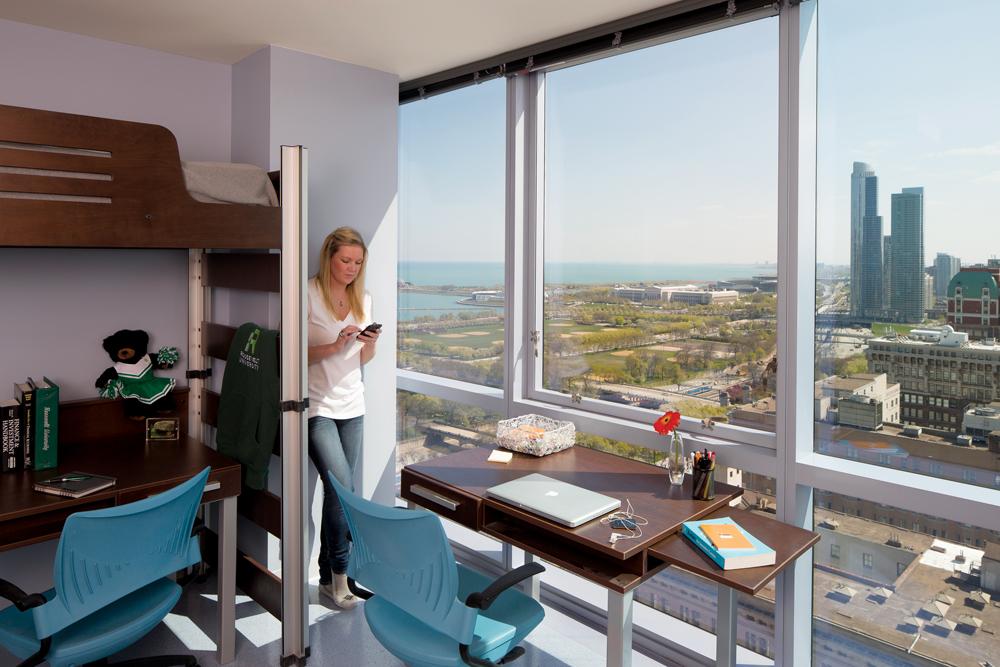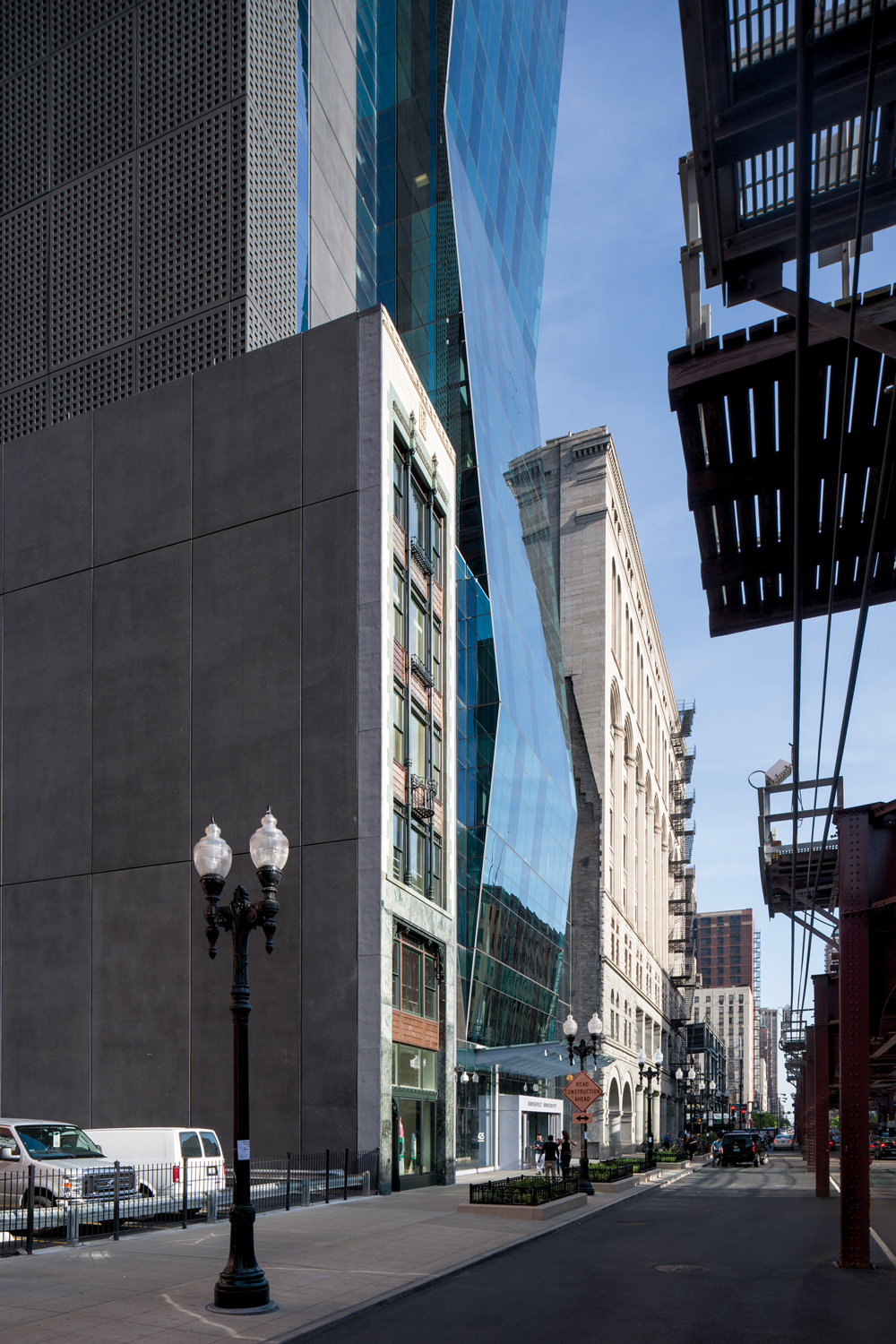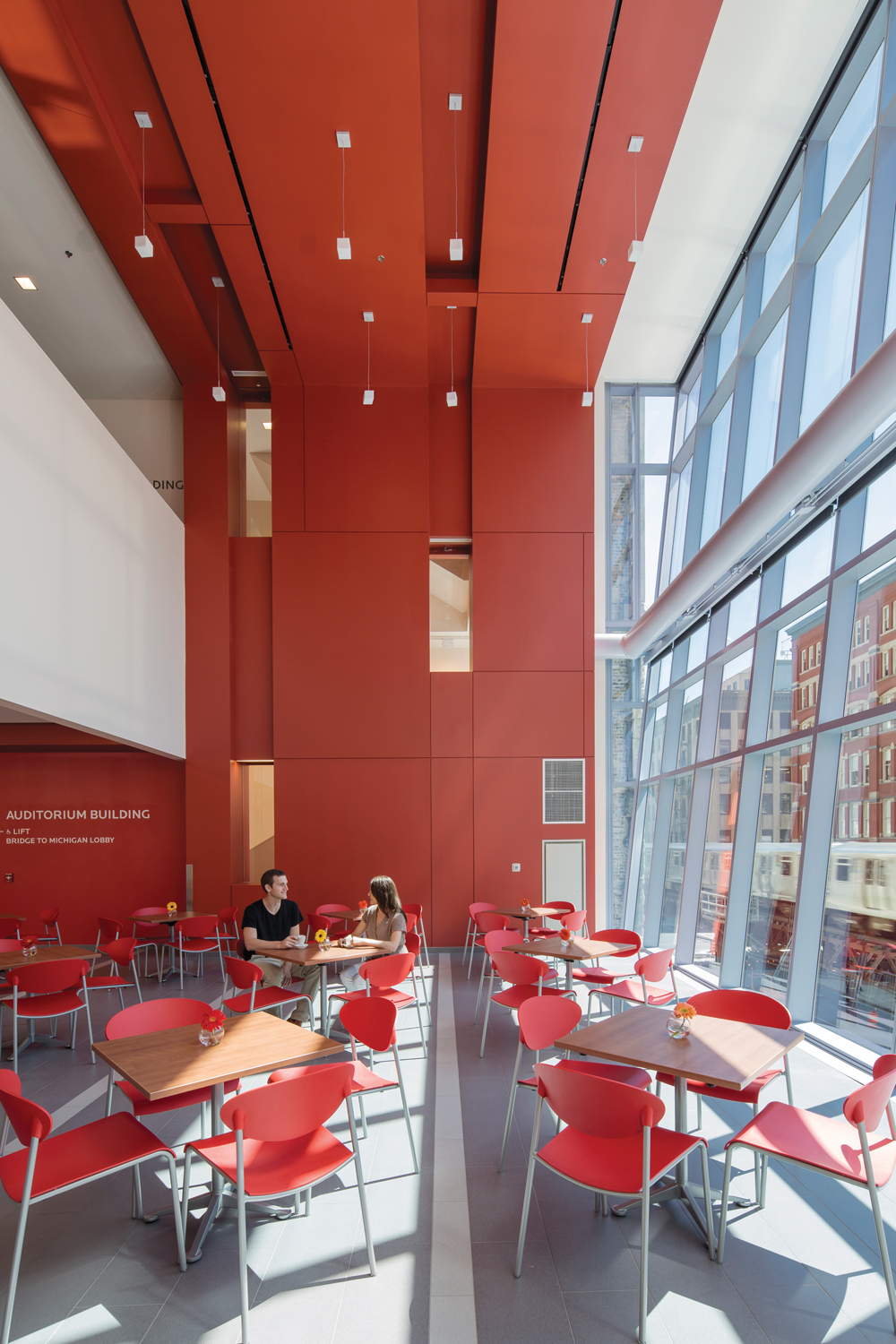Creating a tall facility on a constrained city site always presents special difficulties for Building Teams. Make the program unusually diverse—in this case, combining residential, classroom, laboratory, office, conference, dining, and recreational functions—and the complexity level increases. Now throw in the need to link the facility to a landmark 1880s structure with different floor-to-floor heights. Finally, have the city of Chicago “orange tag” one of two existing buildings on your site, derailing your plans for a complete demolition.
The Building Team for Roosevelt University’s new Wabash Building successfully navigated this minefield, producing a distinctive addition to the South Loop skyline and an appealing new home for the school. Architect VOA Associates, owner’s rep Jones Lang LaSalle, development advisor The John Buck Company, and Power Construction spearheaded a successful functional and aesthetic collaboration that also achieved LEED Gold. The resulting project, at 469 feet in height, is the second-tallest university facility in the U.S. and the sixth-tallest in the world.
From the start, the project was vastly more complex than anything the client had ever attempted. Roosevelt was already occupying the Auditorium Building, a Michigan Avenue icon designed by Adler and Sullivan, as well as a suburban extension campus. To support enrollment growth and program expansion, the university decided to create a tall building that would consolidate many functions while integrating well with the Auditorium.
Student residences include 633 beds on 17 floors, mostly in four- and five-person suites consisting of single and double bedrooms sharing a bathroom. Laundry facilities on the 15th floor feature Internet tracking so students can make sure washers and dryers are available before making the trek. Each residential floor has a large study room with breathtaking lake and city views.
With a footprint of only 17,300 sf, the tight site would need to accommodate a program of ~420,000 sf. A nondescript ’70s high-rise Roosevelt had once used for a dorm was demolished. The attractive façade of the adjacent Fine Arts Annex, a slender six-story structure built in the 1920s, was saved to become the front of a student bookstore.
The design solution created a “servant-served” spatial relationship, placing core and support (“servant”) spaces on the north elevation behind a fairly plain precast concrete façade, with unglazed lower floors giving way to a checkerboard window grid higher up. The functional (“served”) spaces are situated on the south side, featuring blue glass and dramatic canted faces inspired by Brancusi’s famed Endless Column sculpture, as well as the faceted façade of the nearby Spertus Institute of Jewish Studies. The servant-served arrangement maximizes spectacular views to the south, east, and west.
Common areas are clustered in the five lowest floors, including a two-story atrium lobby, student services offices, a student union, a dining hall, and a recreation facility. Classroom and lab spaces and a mechanical floor occupy the midsection, topped by 17 stories of residences.
The servant-served organization maximizes clear spans for the large classrooms and labs, including seven classrooms with a capacity of 36 students each, four tiered classrooms seating 60 to 80, and three auditorium classrooms seating 78 to 180. Judiciously placed prefunction spaces serve as interior “quads” for student interaction.
The façade of the slender 1920s building in the foreground was preserved as the front of a new bookstore. The dark, plain north elevation of the new tower, which faces another tall building, delineates the service functions on this side.
Three stories of science labs support instruction and research in biology, chemistry, and physics, as well as office space for science faculty. Roosevelt’s Heller College of Business was also moved to the new skyscraper from a different Loop facility; its students now benefit from a simulated financial trading room and retail store.
Vertical and horizontal circulation within the Roosevelt campus is necessarily complex. Round-the-clock security check-in is required at Floor 14 before students can proceed to the higher levels via dedicated elevators. Hooking the tower onto the Auditorium Building to the south was also tricky but crucial; the older building is still heavily used for classrooms and offices, as well as performances in beautifully restored ArtNouveau theater spaces. Gently sloping hallways now connect the buildings at four points, with generous signage provided to ease wayfinding.
Getting to LEED Gold required an imaginative mix of strategies, from the typical— high-efficiency HVAC, low-flow plumbing, green roofs—to the less common. In the latter category: removable pillow-tops to maximize mattress life cycle, façade patterning intended to deter bird collisions, a food pulper that allows dining hall waste to be hauled off and composted, and a complex network of recycling chutes with an anti-microbial washdown system.
The second-floor dining center seats 300 and offers a mini-mart for snacks and sundries, as well as cold carryout items, hot food, pizza, a deli, a grill station, and a coffee shop.
Structural and logistical issues demanded creative solutions as well, particularly with respect to crane deployment. Many projects on tight urban sites are built around a central crane, resulting in the need to finish the resulting “dead zone” after the crane is dismantled near the end of the job. Engineering-intensive lab spaces in the Wabash Building’s midsection made this scenario particularly unpalatable. Instead, the Building Team devised a method for mounting the crane outside the building footprint, using counterbalance weights and a crane elevator that hugged the façade.
Today, the Wabash Building is a lively, 24/7 community that brings the school’s social justice mission to life, hosting students from 34 states and more than a dozen countries. Chicago Tribune architecture critic Blair Kamin is among the admirers of Roosevelt’s bold experiment: “It achieves a genuine, artful dialogue between past and present … a building of considerable promise.”
This tiered classroom is one of several large, general instructional spaces provided in the building’s middle floors. Thoughtfully planned daylighting is a hallmark of the project.
Project summary
GOLD AWARD
Roosevelt University Wabash Building
Chicago
BUILDING TEAM
Submitting firms: VOA Associates (architect) and Jones Lang Lasalle (owner’s rep)
Development advisor: The John Buck Company
Associate architect: Johnson & Lee Ltd.
Structural: Magnusson Klemencic Associates
MEP: WMA Consulting Engineers
Contractor: Power Construction
GENERAL INFORMATION
Project size: 420,000 sf
Construction cost: $123 million
Construction time: November 2009 (demolition) to March 2012 (completion)
Delivery method: Design/bid/build
Related Stories
Construction Costs | Feb 27, 2024
Experts see construction material prices stabilizing in 2024
Gordian’s Q1 2024 Quarterly Construction Cost Insights Report brings good news: Although there are some materials whose prices have continued to show volatility, costs at a macro level are returning to a level of stability, suggesting predictable historical price escalation factors.
High-rise Construction | Feb 23, 2024
Designing a new frontier in Seattle’s urban core
Graphite Design Group shares the design for Frontier, a 540,000-sf tower in a five-block master plan for Seattle-based tech leader Amazon.
Construction Costs | Feb 22, 2024
K-12 school construction costs for 2024
Data from Gordian breaks down the average cost per square foot for four different types of K-12 school buildings (elementary schools, junior high schools, high schools, and vocational schools) across 10 U.S. cities.
MFPRO+ Special Reports | Feb 22, 2024
Crystal Lagoons: A deep dive into real estate's most extreme guest amenity
These year-round, manmade, crystal clear blue lagoons offer a groundbreaking technology with immense potential to redefine the concept of water amenities. However, navigating regulatory challenges and ensuring long-term sustainability are crucial to success with Crystal Lagoons.
Architects | Feb 21, 2024
Architecture Billings Index remains in 'declining billings' state in January 2024
Architecture firm billings remained soft entering into 2024, with an AIA/Deltek Architecture Billings Index (ABI) score of 46.2 in January. Any score below 50.0 indicates decreasing business conditions.
University Buildings | Feb 21, 2024
University design to help meet the demand for health professionals
Virginia Commonwealth University is a Page client, and the Dean of the College of Health Professions took time to talk about a pressing healthcare industry need that schools—and architects—can help address.
AEC Tech | Feb 20, 2024
AI for construction: What kind of tool can artificial intelligence become for AEC teams?
Avoiding the hype and gathering good data are half the battle toward making artificial intelligence tools useful for performing design, operational, and jobsite tasks.
Engineers | Feb 20, 2024
An engineering firm traces its DEI journey
Top-to-bottom buy-in has been a key factor in SSOE Group’s efforts to become more diverse, equitable, and inclusive in its hiring, mentoring, and benefits.
Building Tech | Feb 20, 2024
Construction method featuring LEGO-like bricks wins global innovation award
A new construction method featuring LEGO-like bricks made from a renewable composite material took first place for building innovations at the 2024 JEC Composites Innovation Awards in Paris, France.
Codes and Standards | Feb 20, 2024
AISC, AIA release second part of design assist guidelines for the structural steel industry
The American Institute of Steel Construction and AIA Contract Documents have released the second part of a document intended to provide guidance for three common collaboration strategies.





















